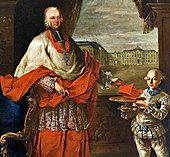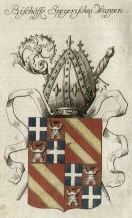Franz Christoph von Hutten to the Stolzenberg
Franz Christoph Baron von Hutten zum Stolzenberg (born March 6, 1706 in Steinbach , today a district of Lohr ; † April 20, 1770 in Bruchsal ) was Prince-Bishop of Speyer and Cardinal of the Roman Catholic Church .
Life
Franz Christoph von Hutten comes from the imperial knightly line of those von Hutten , who had already produced several bishops. He was the son of Franz Ludwig Freiherr von Hutten zu Stolzenberg , bailiff in Homburg an der Wern and later Imperial Councilor and Würzburg senior bailiff in Gerolzhofen in Franconia , and Johanna Juliana, née von Bicken .
Franz Christoph studied law and theology, among other things. He chose the clergy and became canon in Würzburg as a subdeacon .
On November 14, 1743, he became Bishop of Speyer as the successor to Hugo Damian von Schönborn . As Bishop of Speyer, Franz Christoph was also spiritual prince through the secular possession of the diocese, the Hochstift Speyer . He was also the prince provost of Weissenburg . He received papal confirmation of his election as bishop on February 3, 1744, and the Mainz auxiliary bishop Christoph Nebel donated his consecration.
The buildings of the baroque residence of the prince-bishops of Speyer, the Bruchsal Palace , had already been completed by the time Franz Christoph took office, but the rococo- style interior was now taken over by the newly elected prince-bishop. His mercantilist thinking led him to lay the foundation stone for a saltworks in the southern suburb of Bruchsal on June 25, 1748 . At the time, however, the source led from Ubstadt to the northern part of the city. On June 12, 1749, the operation of the salt works was handed over to an association, which also started boiling salt. In 1752 a tobacco factory was built and set up, and later a lace and spinning factory. Bruchsal experienced an economic boom, which in the end did not last long, as the factories did not survive long despite state protection. Franz Christoph and his predecessor placed particular emphasis on the school system: Hugo Damian introduced compulsory schooling, and under Franz Christoph a grammar school was founded in Bruchsal. They also had a love for the musical arts in common, and Franz Christoph is also said to have been a lover of precious stones. However, the two bishops are considered to be very different personalities, which is also shown in the fresco painting of the stairwell in Bruchsal Castle: On the one hand, Prince-Bishop Hugo Damian von Schönborn can be seen as the strict ruler, who clearly points to the castle plan, which is a female one Genius offers him, sitting opposite him with a friendly gesture on the red velvet throne, spreading his arms, his successor Franz Christoph von Hutten.
During times of war and when the emperor was elected, von Hutten always stood up for the House of Habsburg. In 1761 he was appointed cardinal at the instigation of Emperor Franz I Stephan . However , he never traveled to Rome . Prince-Bishop Franz Christoph von Hutten had a sulfur bath built in Bad Langenbrücken in 1766 after the discovery of sulfur springs, which became the basis for the spa business in Bad Langenbrücken
Bishop Franz Christoph died in Bruchsal in 1770. The burial took place on May 11, 1770 in the crypt of the local St. Peter's Church on the side of his predecessor. The heart was buried on May 11, 1770 in front of the Marien Altar in the monastery church in Waghäusel .
In 1797, Hirsching's historical-literary handbook (Volume 3) issued him a brilliant certificate: “He did a lot of good for his diocese. He expanded his residence in Bruchsal, completed the episcopal palace, improved the seminarium, donated a country hospital and gave him 30,000 florins and 50,000 florins for a work house. With Durlach he set up an inheritance contract because of the Eberstein county, and bought the lordship of Neuhausen and Pfauhausen . The whole country revered him as a father and missed him lamentably when he died on April 20, 1770 ”.
coat of arms
The illustrated multiple prince-bishop's coat of arms is quartered . It alternates between the family coat of arms and a second crossing, which symbolizes the bishopric of Speyer and the prince-provost of Weißenburg. The Hutten family coat of arms shows two golden diagonal bars on red.
Honors
Franz Christoph von Hutten is the namesake of Huttenheim , today a district of Philippsburg . After a flood in 1758, von Hutten helped the former village of Knaudenheim to relocate the place to the Hochgestade, which was safe from further flooding. The residents renamed the place out of gratitude.
literature
- Hans Ammerich : The Speyer diocese and its history , Volume 3: From the Reformation to the end of the old diocese ; Kehl am Rhein 1999; ISBN 3-927095-49-4 ; Pp. 26-28.
- Markus Lothar Lamm: The diocese and bishopric of Speyer under the government of Cardinal Franz Christoph von Hutten (1743–1770) ; Sources and treatises on church history in the Middle Rhine region, 95; Mainz: Society for Middle Rhine Church History, 1999; ISBN 3-929135-27-2 (also diss., Kath. Univ. Eichstätt, 1998)
- Heinrich Maas: Administrative and economic history of the Speyer diocese during the reign of Prince-Bishop Franz Christoph von Hutten (1743–1770) ; Wolfenbüttel 1931 (also Phil. Diss., Univ. Göttingen)
- Johannes Pfeiffer : The Speyer Prince-Bishop Franz Christoph Cardinal von Hutten, 1743-1770. His fight against shortcomings and abuse in his diocese. At the same time a contribution to the history and judgment of the Age of Enlightenment ; Hambach: self-published, 1959
- Markus Weis: The Bruchsal court architect Johann Leonhard Stahl (1729–1774) and the construction work in the Prince Diocese of Speyer under Franz Christoph Cardinal von Hutten ; Sources and treatises on church history in the Middle Rhine region, 67; Mainz: Society for Middle Rhine Church History, 1993 (plus dissertation, Univ. Heidelberg, 1988)
Web links
- Detailed biography
- "His court was magnificent and numerous" - anniversary exhibition in Bruchsal 2006
- Biographical website of the city of Philippsburg
- Hutten, Franz Christoph von (1706–1770). In: Salvador Miranda : The Cardinals of the Holy Roman Church. ( Florida International University website, English)
- Entry on Franz Christoph von Hutten zum Stolzenberg on catholic-hierarchy.org
- Franz Christoph von Hutten zum Stolzenberg in the Saarland biographies
Individual evidence
- ↑ Data page on Bishop Nebel on Catholic Hierarchy
- ^ Source from Ubstadt ff. However, the company made little profit and was therefore leased to Lieutenant Colonel Johann Andreas von Traitteur on August 4, 1798 and sold to him on December 23, 1811.
| predecessor | Office | successor |
|---|---|---|
| Hugo Damian von Schönborn |
Prince-Bishop of Speyer and Prince Provost of Weissenburg 1743–1770 |
Damian August Philipp Karl of Limburg-Stirum |
| personal data | |
|---|---|
| SURNAME | Hutten zum Stolzenberg, Franz Christoph von |
| ALTERNATIVE NAMES | Hutten zu Stolzenberg, Franz Christoph Freiherr von |
| BRIEF DESCRIPTION | Bishop of Speyer and Cardinal |
| DATE OF BIRTH | March 6, 1706 |
| PLACE OF BIRTH | Steinbach, today in Lohr am Main |
| DATE OF DEATH | April 20, 1770 |
| Place of death | Bruchsal |




